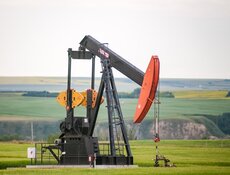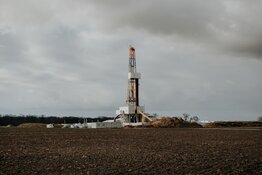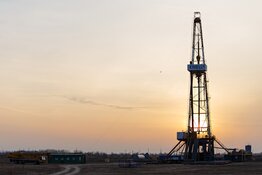Neal Dingmann: To a degree, I am bullish. The market has changed in the last couple of years. When you're talking natural gas, you have to distinguish between dry gas and what they call the "wet gas" or natural gas liquids (NGLs). There are a lot of good companies out there that have both. One might not be all that bullish in the near term on dry gas, which is currently around $4.37 per thousand cubic feet (Tcf). But if those same companies have exposures to liquids, they can still make a tremendous return. I like companies in regions that have exposure to the liquids but, at some point, I believe the natural gas comeback may be sooner than many think.
TER: Do you have a forecast for oil and gas (O&G) commodities?
ND: For natural gas, our estimates are $4.38 per million cubic feet (Mcf) this year and $5.05/Mcf next year. For oil, $97.06/bbl this year and $97.76/bbl next year; so, you could see a little bigger move in natural gas given where it is today.
TER: But do you believe that the margins are there for growth?
ND: Absolutely. As long as companies have liquids or oil exposure to any extent, I think margins can be extremely good.
TER: Why do the liquids have greater margins than the dry?
ND: Because most NGLs are priced as a percentage of oil. Propane, for instance, is probably the lowest at around 25%–30%, all the way up to some natural gasoline at about 90% of the price of oil. So, unlike dry gas, which is going to be at a relatively low price right now, ethane, propane, butane and natural gasoline are essentially priced off the price of a barrel of oil today, which is much higher, marginally speaking.
TER: Why do companies even look for dry gas now?
ND: Obviously, it's tough for a public company to announce today that it's going to do an acquisition for purely dry gas. Private companies can afford to buy and wait until prices come back; public companies can't.
TER: So, public companies producing dry gas are doing it as a byproduct of some other commodity?
ND: That's most of what we're seeing today. The two key geographic areas with a fair number of associated liquids are the Marcellus Shale play in the East, or the Appalachian side, and the Eagle Ford Shale close to San Antonio.
TER: What should an investor look for today, in terms of a balance between oil and gas in a company?
ND: I like companies that are a little more than 50% when you combine the oil and liquids exposure. I believe dry gas should come back in one to three years. If a public company has enough oil/liquids exposure, it will have economic activity and drilling over the next two years to provide sufficient cash flows until gas comes back.
TER: What companies do you see with this balance?
ND: One of my top recommendations would be SandRidge Energy, Inc. (NYSE:SD), which is pretty unique with two primary oil plays—one in the Permian Basin and another in northwest Oklahoma. The company also has a very large conventional gas property in Texas, which could be a huge asset when prices come back. SandRidge is ramping-up production about 15%–20% this year and owns its drilling rigs. Because it is in the Permian and the Oklahoma area, service costs are much lower than in most unconventional areas. The company has some very high hedges, locked in with very economical prices, along with two solid oil plays and an incredibly large gas play.
Another is Magnum Hunter Resources Corp. (NYSE.A:MHR), which is in three of the hottest plays in the U.S.—the Marcellus around the Appalachian, the Eagle Ford in Texas and the Bakken in northern North Dakota. The company controls its own infrastructure, which is a key issue with a lot of small companies. The Marcellus acreage has a very high liquid content, but the company has several hundred-thousand-gas acres, which should do well when gas prices come back.
Magnum Hunter recently acquired NuLoch Resources Inc. (TSX.V:NLR), which has a very experienced team up in the Bakken. NuLoch has the potential to see production go from around 2,000 to 4,000 barrels per day (bpd) in a couple of years. That would be nearly all oil. The Eagle Ford has seen not only great liquid content from the wells, but also decreasing costs due to improved drilling practices. So, I expect not only the results to stay as high, or maybe go higher, but also anticipate the cost of those wells coming down, thus enhancing returns.
TER: Should investors be looking for data points or catalysts from the NuLoch projects?
ND: Absolutely, that acquisition hasn't officially closed yet. NuLoch is a good, but small, company with limited financial resources but a solid operational team. When combined with a company like Magnum, which has a much larger budget, it could really see explosive results.
TER: What other companies should investors consider?
ND: Chesapeake Energy Corp. (NYSE:CHK). People talk about Chesapeake being one of the largest gas producers in the U.S. The company still has a lot of gas going forward. But this year, Chesapeake has focused on more liquids plays with leading positions in the Bakken. It also has big acreage in Niobrara, the Marcellus and Eagle Ford and tends to be one of the lowest-cost producers in all those plays.
Investors are becoming more and more convinced that Chesapeake will follow through with its 25/25 mandate, which means growing production by 25% while simultaneously reducing debt exposure by 25%. It's a nice combination of a large company ramping-up production intelligently and, concurrently, decreasing its debt exposure on a percentage basis. There are other large companies out there that might be as good with similar production upside but, generally, when you have this production upside, you have a debt level that is continuing to expand on a percentage, or debt-to-cap basis. In the case of Chesapeake, we should see debt going down. Also, the company has been very good at putting its operational team expertise to use by finding these plays early, and then partnering with the right financial partner.
Another company is Swift Energy Company (NYSE:SFY). It was known mostly as a Gulf Coast company around the Lake Washington area. But it has more than 70,000 acres in Eagle Ford, which, as mentioned previously, is a very high liquid-concentrated area. Swift has a mandate and overall production should be up to about 25%–30% this year, sequentially—one of the highest in the industry. On top of that, Swift is able to keep its costs down with strong extended frack contracts with Weatherford International Ltd. (NYSE:WFT) on the wells. Also, the company has been in this play and around the Gulf Coast for some time and its acreage prices are a fraction of what some of the newer entrants have paid. Not only does Swift have the big advantage of having high growth, but also exceptionally low costs because it got in these plays early.
I think it is also important to highlight a small company, called Miller Energy Resources (NASDAQ:MILL). Until a year ago, this Tennessee company was predominantly a small gas company with a little bit of associated oil. Miller Petroleum then came to the Cook Inlet in Alaska and bought some very attractive assets out of bankruptcy for a very, very cheap price. The company has tremendous running room, given its thousands of acres up in Alaska, where production could double or potentially triple in the next several quarters. Miller owns its own infrastructure in Alaska, and the state offers tax credits that could amount to as much as 60%–65% of capital invested. What's unique in Alaska is that oil prices have little to no differential to West Texas Intermediate (WTI) prices. So, with WTI at over $100/bbl, oil prices are extremely attractive. It's a very unique small company with tremendous assets—oil, plus natural gas in Alaska.
TER: But MILL has really lagged and is considerably lower than its peer group. Is that because its market cap is so small that the bigger mutual funds are unable to buy it?
ND: I believe that's a good bit of it. Its market cap is only about $200 million. Generally, for a lot of the mutual funds to get in, it has to have a minimum of a $500-million market cap. I believe that in the coming quarters, as we begin to see some production upside, you should start to see the stock price go in sync with that.
TER: What about international companies?
ND: We do have one that I think is very exceptional—TransAtlantic Petroleum Ltd. (TSX:TNP, NYSE:TAT), which has more than 1 million acres in Turkey. The commodity prices are very positive in that region. Gas is between $7 and $8, and oil is right around $100–$115. What's interesting is that TransAtlantic owns all of its services—not just rigs but frack trucks, completion trucks and seismic equipment. With that, the company's costs will stay well under what they would be if relying on foreign companies to provide those services. But clearly, it takes this company longer to set up operations because it still needs to bring in many services from the U.S.
TransAtlantic recently closed on a couple of large acquisitions. The company has two primary areas. One is Thrace Basin, northwest of Istanbul, which is predominantly natural gas. A number of wells are starting to be drilled and fracked there and it is taking off exponentially. Another area is southeast Turkey, almost on the Iraqi-Syrian border, where a fair amount of oil drilling is expected. Between the combination of Thrace and southeast Turkey, we believe production is somewhere around 5,000 bpd. We believe production could reach 10,000 bpd this year and 20,000 bpd next year. Compared to domestic companies, its production model could be one of the leaders.
TER: You forecast that TransAltantic could ramp-up production by more than 200% this year. Is that correct?
ND: Absolutely. Most people would probably agree that the reserves are in the ground on the massive acres the company holds. Obviously, the questions are always: Can the company get it out of the ground? And how soon can it get it out of the ground? We believe that because the services are all there and most of the processes are in place, we should now see the benefit of all that. You saw production begin this year somewhere around 4,000 bpd, and we could see an exit rate well north of 10,000 bpd.
TER: You mentioned that TransAtlantic has its own infrastructure. Does that all come under the heading of Viking International?
ND: It does. Viking International is a subsidiary of TransAtlantic, which is trading at about $2.87/share or about a $1 billion market cap. Some might argue that one-third or even more of that market cap is comprised of the book value of Viking International.
TER: Has the stock lagged thus far because it hasn't begun the growth part of its production?
ND: That's likely the reason. Usually, most mutual or hedge funds are able to come in and acquire a company like this at $1 billion. The plan would be to ramp-up that production to somewhere around 20,000–40,000 bpd. That would put it on the radar of a lot of the majors and some of these other large foreign players looking for a large oil or gas play. At that point, the company would probably sell to one of the large E&P companies, which would be very positive for shareholders.
TER: Could Turkey be considered a geopolitically risky area, and is there a risk discount trading in this stock currently?
ND: You've brought up a good point. With any company not primarily a domestic, there is always going to be some discount in the stock price for potential geopolitical risk. The objective for investors is to determine the appropriate discount. Today, due to potential turmoil in parts of the Middle East and other areas, there may be some over discounting of TransAtlantic's stock price. When some of this other turmoil starts to die down again, you may start to see investors come back in a larger way.
TER: Thank you for your time.
Neal Dingmann has more than 12 years of equity research experience, most recently at Wunderlich Securities where he covered more than 30 companies in the exploration and production and oilfield services sectors. He previously held similar positions at Dahlman Rose, Pritchard Capital, RBC Capital Markets and Banc of America Securities, where he worked on the number one-ranked Oilfield Services research team. Last year, Neal was recognized by The Wall Street Journal as "Best on the Street" and as a "Home Run Hitter" by Institutional Investor magazine. He is a frequent guest on Bloomberg TV and has a large network of industry contacts. Neal received his MBA from the University of Minnesota and his BA degree in business from the University of Arkansas.
Want to read more exclusive Energy Report interviews like this? Sign up for our free e-newsletter, and you'll learn when new articles have been published. To see a list of recent interviews with industry analysts and commentators, visit our Expert Insights page.
DISCLOSURE:
1) George Mack of The Energy Report conducted this interview. He personally and/or his family own shares of the following companies mentioned in this interview: None.
2) The following companies mentioned in the interview are sponsors of The Energy Report: TransAtlantic Petroleum.
3) Neal Dingmann: I personally and/or my family own shares of the following companies mentioned in this interview: None. I personally and/or my family am paid by the following companies mentioned in this interview: None.
Companies Neal Dingmann Covers:
Abraxas Petroleum (NAS:AXAS)
Basic Energy Services (NYSE:BAS)
Bill Barrett (NYSE:BBG)
BPZ Resources (NYSE:BPZ)
Brigham Exploration (NAS:BEXP)
Callon Petroleum (NYSE:CPE)
Chesapeake Energy (NYSE:CHK)
Clayton Williams (NAS:CWEI)
Complete Energy Services (NYSE:CPX)
Concho Resources (NYSE:CXO)
Continental Resources (NYSE:CLR)
Denbury Resources (NYSE:D(NR)
Endeavour International (NYSE: END)
EQT Resource (NYSE:EQT)
Gastar Exploration (NYSE:GST)
Georesources (NAS:GEOI)
Gran Tierra Energy (NYSE:GTE)
Gulfport Energy (NAS:GPOR)
Key Energy Services (NYSE:KEG)
Lufkin Industries (NAS:LUFK)
Magnum Hunter Resources (NYSE:MHR)
Miller Petroleum (NAS:MILL)
Newpark Resources (NYSE:NR)
Northern Oil & Gas AMEX:NOG)
Penn Virginia (NYSE:PVA)
PetroHawk Energy (NYSE:HK)
Range Resources (NYSE:RRC)
Resolute Energy (NYSE:REN)
Rex Energy (NAS:REXX)
Rosetta Resources (NAS:ROSE)
RPC Inc (NYSE:RES)
SandRidge Energy (NYSE:SD)
Swift Energy (NYSE:SFY)
TransAtlantic Petroleum Ltd. (TSX:TNP, NYSE:TAT)
Venoco (NYSE:VQ)
Voyager Oil & Gas AMEX:VOG)
Whiting Petroleum (NYSE:WLL)








































